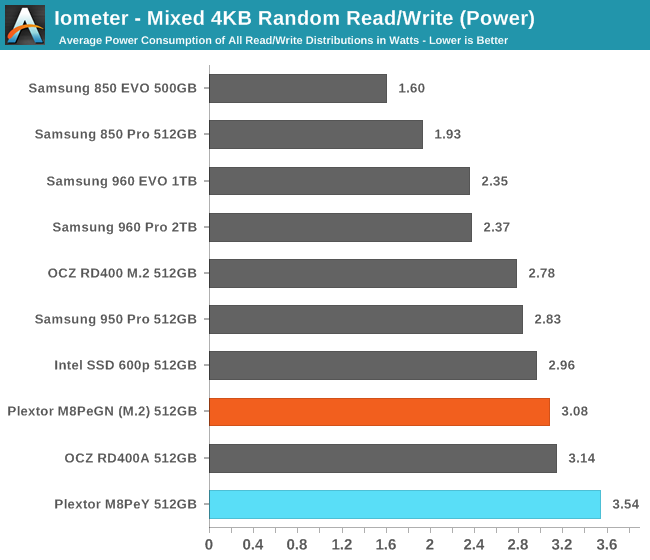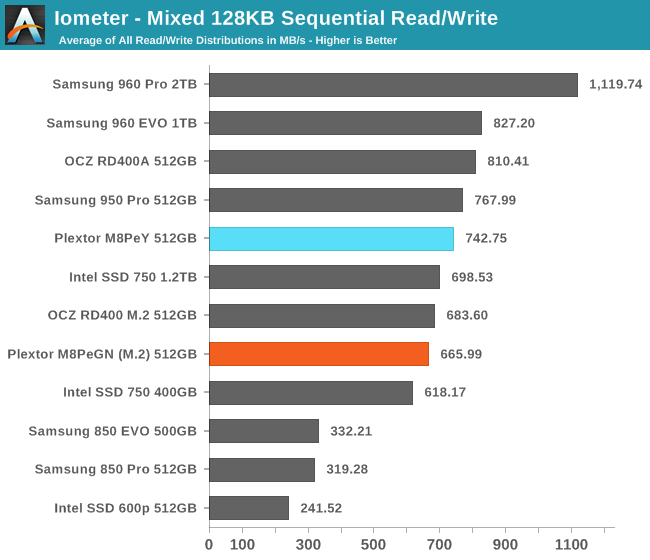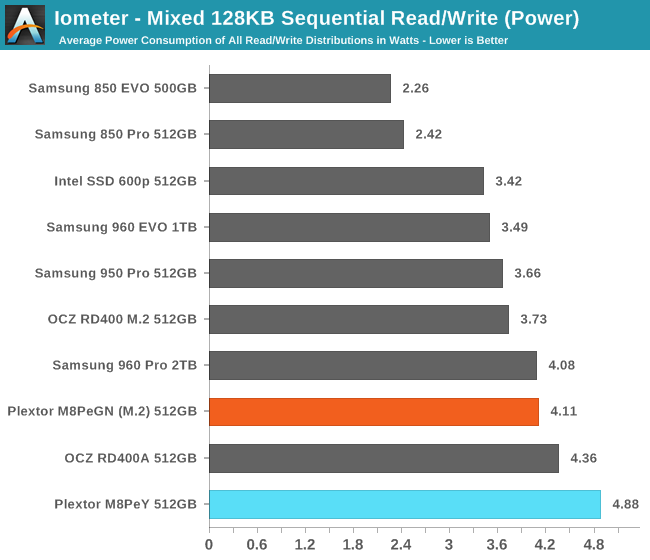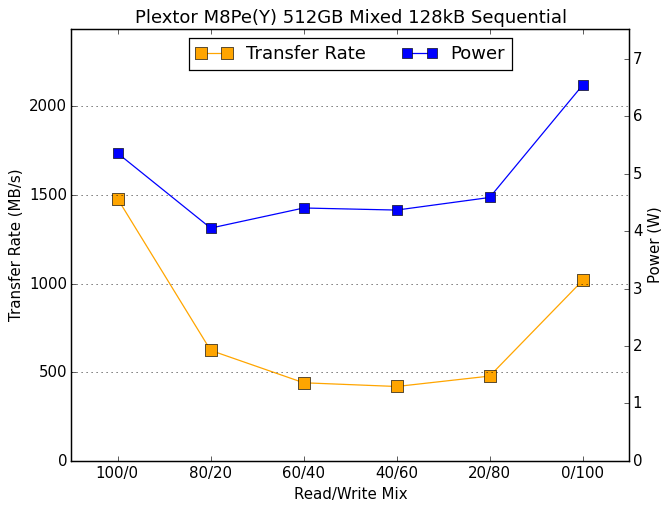The Plextor M8Pe (512GB) SSD Review
by Billy Tallis on December 14, 2016 9:00 AM ESTMixed Random Read/Write Performance
The mixed random I/O benchmark starts with a pure read test and gradually increases the proportion of writes, finishing with pure writes. The queue depth is 3 for the entire test and each subtest lasts for 3 minutes, for a total test duration of 18 minutes. As with the pure random write test, this test is restricted to a 16GB span of the drive, which is empty save for the 16GB test file.

With a relatively low queue depth, this test is mostly about the access latency of the flash itself, and it's no surprise that the heatsink makes no difference to the M8Pe's performance. The M8Pe is slightly faster than the older Intel SSD 750 and Samsung 950 Pro, but is slower than the OCZ RD400 and Samsung 960 Pro.

Power consumption is again higher than the competition, giving the M8Pe in either configuration a poor efficiency score.
 |
|||||||||
Performance increases relatively slowly as the proportion of writes increases; this is unsurprising given that we've already seen the M8Pe's strengths lie in its read speeds. The spike in performance in the final all-writes phase of the test is respectable and brings the average up to a typical score for this product segment.
Mixed Sequential Read/Write Performance
The mixed sequential access test covers the entire span of the drive and uses a queue depth of one. It starts with a pure read test and gradually increases the proportion of writes, finishing with pure writes. Each subtest lasts for 3 minutes, for a total test duration of 18 minutes. The drive is filled before the test starts.

The data rates on the mixed sequential I/O test are high enough that thermal throttling becomes a factor, and the presence of a heatsink improves the M8Pe's average by 11%. Performance in either configuration is a bit sub-par for an MLC-based PCIe SSD, but it's still at least twice as fast as any SATA SSD.

Power consumption is again the highest of any M.2 PCIe SSD, and efficiency isn't great.
 |
|||||||||
There appears to be a little bit of thermal throttling during the first phase of this test, but most of it occurs at the end when the workload is all writes.










64 Comments
View All Comments
Magichands8 - Wednesday, December 14, 2016 - link
This is amazing! Tiny 128GB SSDs for $0.64/GB! And look at that 1TB for $0.51/GB! We even get to use a crappy Microsoft bundled driver for these! Who knows, in 2017 we may even get to see consumer SSDs reach $0.80, $0.90 or even $1+ per GB... Time doesn't stand still and neither does the endless march of progress. Brace yourselves guys, the future's going to be an amazing place.ironwing - Thursday, December 15, 2016 - link
What is a the reason that PCIe SSDs consume more power than SATA SSDs? Is it simply the higher speeds? The review covered the sleep state issues with the PCIe drives but when the drives are in a similar state, the SATA drives appear to be much more power efficient.Billy Tallis - Thursday, December 15, 2016 - link
I think the biggest problem is that the NVMe power saving states I'm testing don't include reducing the PCIe link speed or width. Keeping a PCIe 3.0 x4 link lit up takes a significant amount of power. The SATA drives by contrast are being told to put the SATA link in a low power state and take that as the signal to engage internal power saving mechanisms.bbhaag - Thursday, December 15, 2016 - link
Thanks for the great review Billy. I've been holding off on buying the Plextor for my new build hoping that Anandtech would put up a review and you guys delivered. Looks like they are solid drives at a mediocre price point. I knew I should have bought the 512 version when the egg had it for 179...sigh...oh well I can wait.DigitalFreak - Thursday, December 15, 2016 - link
$50 price difference for a heatsink? Really?Bruce427 - Friday, December 16, 2016 - link
I think that price includes a PCIe card as well.Bruce427 - Friday, December 16, 2016 - link
At first glance at published specks, it appears that the New Corsair MP500 NVMe drive may outperform the PlextorM8Pe for about the same price.Bruce427 - Friday, December 16, 2016 - link
Sorry, spell check got me. That should have been "specs."Bruce427 - Friday, December 16, 2016 - link
"specs"Billy Tallis - Friday, December 16, 2016 - link
The Corsair MP500 uses the Phison E7 controller. Next week I should have a review up of the Patriot Hellfire that is essentially the same drive. It's slower than the M8Pe on almost every test.